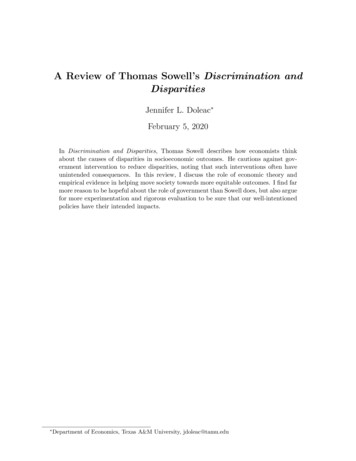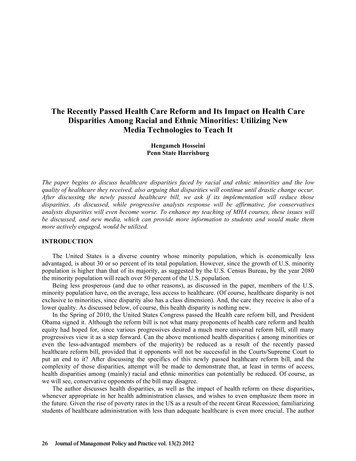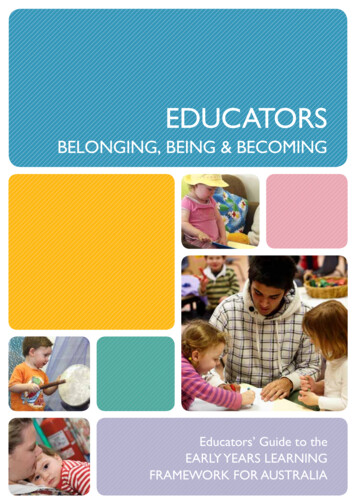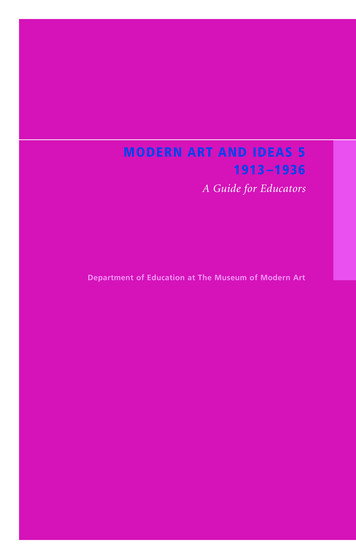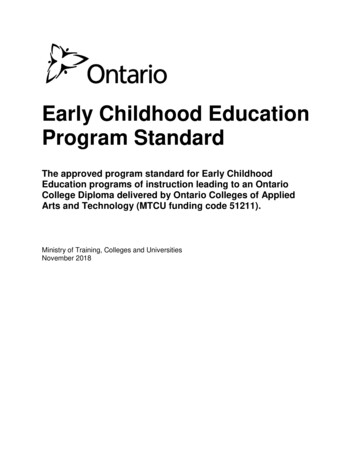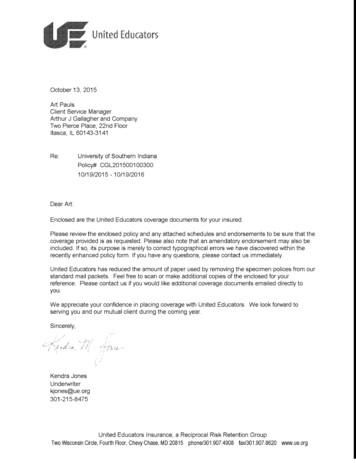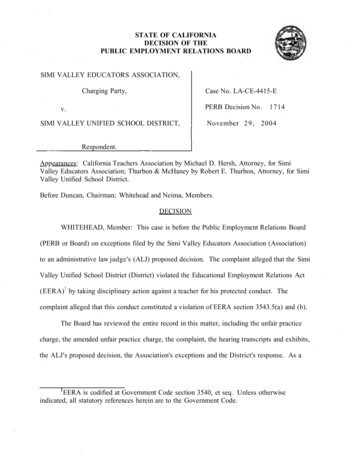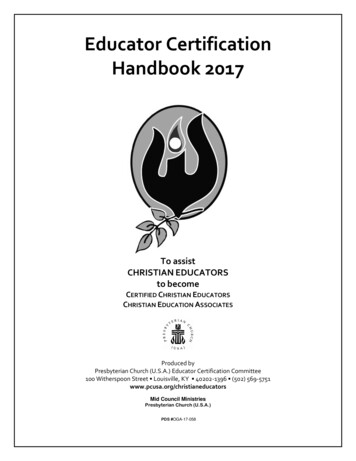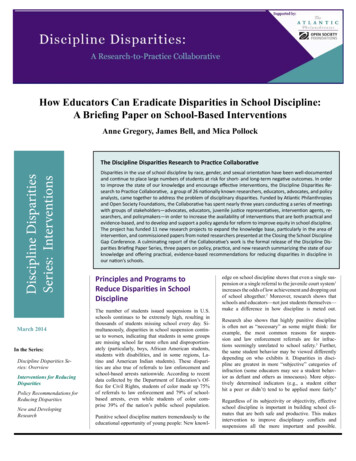
Transcription
How Educators Can Eradicate Disparities in School Discipline:A Briefing Paper on School-Based InterventionsAnne Gregory, James Bell, and Mica PollockDiscipline DisparitiesSeries: InterventionsThe Discipline Disparities Research to Practice CollaborativeMarch 2014In the Series:Discipline Disparities Series: OverviewInterventions for ReducingDisparitiesPolicy Recommendations forReducing DisparitiesNew and DevelopingResearchDisparities in the use of school discipline by race, gender, and sexual orientation have been well-documentedand continue to place large numbers of students at risk for short- and long-term negative outcomes. In orderto improve the state of our knowledge and encourage effective interventions, the Discipline Disparities Research to Practice Collaborative, a group of 26 nationally known researchers, educators, advocates, and policyanalysts, came together to address the problem of disciplinary disparities. Funded by Atlantic Philanthropiesand Open Society Foundations, the Collaborative has spent nearly three years conducting a series of meetingswith groups of stakeholders—advocates, educators, juvenile justice representatives, intervention agents, researchers, and policymakers—in order to increase the availability of interventions that are both practical andevidence-based, and to develop and support a policy agenda for reform to improve equity in school discipline.The project has funded 11 new research projects to expand the knowledge base, particularly in the area ofintervention, and commissioned papers from noted researchers presented at the Closing the School DisciplineGap Conference. A culminating report of the Collaborative’s work is the formal release of the Discipline Disparities Briefing Paper Series, three papers on policy, practice, and new research summarizing the state of ourknowledge and offering practical, evidence-based recommendations for reducing disparities in discipline inour nation’s schools.Principles and Programs toReduce Disparities in SchoolDisciplineThe number of students issued suspensions in U.S.schools continues to be extremely high, resulting inthousands of students missing school every day. Simultaneously, disparities in school suspension continue to worsen, indicating that students in some groupsare missing school far more often and disproportionately (particularly, boys, African American students,students with disabilities, and in some regions, Latino and American Indian students). These disparities are also true of referrals to law enforcement andschool-based arrests nationwide. According to recentdata collected by the Department of Education’s Office for Civil Rights, students of color made up 75%of referrals to law enforcement and 79% of schoolbased arrests, even while students of color comprise 39% of the nation’s public school population.Punitive school discipline matters tremendously to theeducational opportunity of young people: New knowl-edge on school discipline shows that even a single suspension or a single referral to the juvenile court system1increases the odds of low achievement and dropping outof school altogether.2 Moreover, research shows thatschools and educators—not just students themselves—make a difference in how discipline is meted out.Research also shows that highly punitive disciplineis often not as “necessary” as some might think: forexample, the most common reasons for suspension and law enforcement referrals are for infractions seemingly unrelated to school safety.3 Further,the same student behavior may be viewed differentlydepending on who exhibits it. Disparities in discipline are greatest in more “subjective” categories ofinfraction (some educators may see a student behavior as defiant and others as innocuous). More objectively determined indicators (e.g., a student eitherhit a peer or didn’t) tend to be applied more fairly.4Regardless of its subjectivity or objectivity, effectiveschool discipline is important in building school climates that are both safe and productive. This makesintervention to improve disciplinary conflicts andsuspensions all the more important and possible.
The key question for educators is how to initiate change in school discipline so that moreyoung people remain in school.The Discipline Disparities Research to Practice Collaborative (Collaborative), supportedby the Atlantic Philanthropies and the OpenSociety Foundation, has convened diversestakeholders—advocates, educators, juvenilejustice representatives, intervention agents,researchers, and policymakers—in a series ofmeetings from 2011 to 2013. Our goal wasto address and reduce disparities in both discipline and juvenile justice system involvement by supporting educators in buildingacademically rigorous and engaging schoolsstrengthened by diversity, rooted in cooperation, committed to strong and sustained relationships, and attentive to bias or disparityacross lines of race/ethnicity, gender, sexuality, disability and/or immigration status (seethe Collaborative’s Discipline Disparities Series: Overview, 2014).Synthesizing what we have learned, wehere provide starting points that educators—including teachers, administrators,paraprofessionals, and support personnel—might use to begin shifting disciplinary conflicts and consequences toward aless conflict-ridden school climate, benefitting both educators and students.Throughout, we offer interventions and solutions to help educators avoid the criminalization of child and adolescent behaviors andto literally keep students out of the juvenilejustice system, with an eye toward supporting positive youth development. By criminalization we mean the tendency for adultsto unjustifiably perceive student appearance,body language, or behavior as threateningor defiant of authority and rules, which thenleads to adults issuing punitive sanctions including suspension and often, justice systemreferrals (rather than engaging the student inschool-based prevention and intervention).Discipline Disparities in theLarger Context of SchoolingAvoiding unnecessary or unfair discipline is often not just good school policy,but the law. Recent guidance from the USDepartment of Justice and Education outlines ways in which discipline policies having “disparate impact” –students from somegroups are subjected to discipline more often,or discipline for the same offense is harsherfor some groups than others—may violatecivil rights.5 If the groups in question areprotected by civil rights laws, this disparate2impact is potentially unlawful if either ofthe two following conditions is met: 1) Thepolicy or practice is not educationally necessary; or 2) even when necessary, if otherless discriminatory alternatives are availableand could reasonably meet the objectivesof the policy or practice in question.6 Concerned about the possibility of civil rightsviolations, many schools and school districts have begun to change discipline policies that emphasize removal from instructionas the primary response to rule infractions.Discipline issues in schools both cause adenial of education opportunity and canreflect a need for opportunities to learn.Research shows that disparities arise fromsome student groups being treated differently than others: members of some groupsare disciplined heavily for behaviors thatothers either don’t get disciplined for, orthat they are disciplined less harshly, or receive non-punitive responses. Research alsoshows that disparities arise from differential access to opportunity. This means thatsome students have access to more exciting opportunities to learn than others—andstudents more engaged in exciting or supportive education projects are less likely tohave disciplinary conflicts with educators.7Interventions resolve andeducate, rather thandeport or discipline.School discipline cannot be viewed in isolation from the rest of schooling. Clearly,some schools more than others face tremendous challenges. For example, many of theschools charged with educating a disproportionate share of students who are strugglinglearners are under-resourced in terms of financing and staffing. Even in these environments however, it is not possible to simplyremove the “bad apple” student or the “badapple” teacher; without a change in schoolclimate more “bad apples” may arise thatsimply replace the old ones. Research showsthat school discipline cannot be viewed inisolation from the rest of schooling. Instead,behavior is produced throughout the schoolday as students and educators interact withone another in classrooms and hallways. Toreduce disparities in discipline and decreasethe time and energy put into punishing rulebreaking, effective schools move away fromblaming individual educators for disciplinedisparities and consider the conditions forlearning and the school climate more broadly.Thus, we need sophisticated ways to thinkabout school safety and discipline that canpromote orderly and healthy instructionalclimates while reducing time out of school,inequitable discipline and criminalization.Research is showing that effective discipline creates a shift from a climate in whichmany students are suspended, expelled, overpoliced, or punished regularly, to a culturethat promotes healthy relationships and academic success across classrooms, hallways,and lunchrooms. Interventions resolve andeducate, rather than deport or discipline.Moving beyond Punitive Discipline to Conflict Prevention and Conflict InterventionIn this brief, we present research-based principles to support educators in moving towarda diverse community of highly engaged student and staff learners, grouped into the categories of “Conflict Prevention” and “Conflict Intervention.” The likelihood of conflictis reduced (prevention) when schools create diverse communities of motivated, invested, and engaged learners. As with allcommunities, some conflict is inevitable.When conflict happens, it can be addressedin a constructive and equitable manner (intervention). Such constructive responses toconflict reduce unnecessary discipline, teachstudents appropriate alternatives, and builda school climate that is ultimately stronger.While the most persistent and well-documented school discipline disparities are forAfrican American males and students withdisabilities,8 there is growing evidence thatAfrican American females, gender nonconforming youth, and sexual minorities(LGBT) are increasingly filling the ranks ofthose issued disciplinary exclusion9 and excessive criminal sanctions. The increasingnumber of groups who are at-risk for schoolexclusion and arrest suggests that schooldiscipline can be an inadvertent strategy forhandling difference—differences that mayfall along many lines (race, gender, socialclass, immigrant status, gender identity, sexual orientation, language status, disability).Thus, this paper is based on an explicit equity orientation, guiding educators throughthe principles of prevention and intervention.Interventions for Reducing Disparities Briefing Paper
Principles of Conflict PreventionResearch suggests that to prevent unnecessary discipline and to prevent the overrepresentation of particulargroups of children and adolescents in school discipline, educators can equitably offer all students: Supportive Relationships (Forge authentic connections with all students)Academic Rigor (Promote the potential of all students, hold high expectations, and provide high-levellearning opportunities)Culturally Relevant and Responsive Teaching (Teaching that responds respectfully to students’ real lives)Bias-free Classrooms and Respectful School Environments (Create inclusive, positive classroom and schoolenvironments in which students feel fairly treated)Principles of Conflict InterventionResearch suggests that when discipline problems arise, educators can engage in equity-driven: Inquiry into the Causes of ConflictsProblem-solving Approaches to DisciplineRecognition of Student and Family Voice and their Perspectives on Conflicts’ Causes and SolutionsRe-integration of Students after ConflictFulfilling the promise of schools as hubs forstudent development requires that a commitment to equity be in the forefront of efforts toreduce discipline and discipline disparities.Nor can it be assumed that new programming will, in and of itself, reduce differentialtreatment in discipline or change differentialaccess to learning opportunity. Research hasshown that it is possible to reduce suspension and expulsion10 or the use of schoolbased ticketing and arrests without changing racial disparities in those outcomes.11The equity-oriented principles of preventionand intervention are discussed in detail in thefollowing pages. We describe how each principle relates to disparities in school discipline,and offer strategies and sample programs tohelp guide schools in enacting the principles.Principles of ConflictPreventionOffer Supportive RelationshipsWhat do supportive relationships have to dowith racial and gender disparities in schooldiscipline?Both research and practice show that trusting,supportive relationships between studentsand educators are key to preventing conflict.12 Through caring relationships, schoolstaff can communicate high expectations forstudent engagement in learning as well asdemonstrate their fair and consistent application of school rules.13peers”) and avoid rigid and global judgmentsabout the student (e.g., “she is a bad seed”).All too often, however, supportive relationships are not evenly distributed among student groups. Compared to White students,Black and Latino students believe feweradults are supportive and fair,14 which hasreal consequences for school outcomes. Ina national sample of LGBT youth from over3,000 school districts, almost half of surveyedyouth reported that school staff did nothing when they heard homophobic remarks.15Knowing students well goes a long way.Effective educators get to know their students well, especially those students whoselived experience differs substantially fromtheir educators’ experience. While race andclass categories do not totally determine ourlived experiences, they shape them. Giventhat America’s teaching force is predominantly White and middle-class, differencesin lived experience can be (or are perceivedto be) pronounced for low-income studentsand students of color. Educators’ connectedness to their individual students, as well asto ongoing events in students’ communities,can bridge any “identity gulf” and stop misjudgments, unintentionally hurtful comments(“microaggressions”), or overly harsh reactions to child and adolescent misbehavior.16Getting to know the strengths in students’communities has similar effects. Administrators highlight how essential it is for themto regularly engage with families and community leaders outside of school in order tobuild trust and open lines of communication.From adults’ perspectives, establishing relationships with students is not as simple as itmight seem. Some educators worry about getting “too close,” or about “crossing the line”from teacher to “social worker.” Many educators now fear they will not be able to staytrue to the role of “confidant” if they need toswitch to the role of “mandated reporter” whenthey hear hints of victimization or bullying.But educators who have supportive relationships with their students know much moreabout those students than just their academicperformance. They are aware of major familyevents that are affecting a student’s mood orfocus in class. They read a student’s subtlebody language, which helps them identify the student’s feelings or comfort levelin a social setting. They identify studentstrengths outside of the classroom. Adultswho know their students well tend to viewbehavior in context (e.g., “he’s strugglingright now at home and is taking it out on hisSupportive relationships may reduce negative stereotyping and implicit bias (measurable bias that people don’t even knowthey have). When students and educators getto know each other well, understanding andtrust are built.17 Through trust and good will,students may feel accepted and honored forwho they are, even if who they are differsradically from the teachers’ own experienceInterventions for Reducing Disparities Briefing Paper3
and identity. And knowing who students actually are is what counteracting stereotypesis all about.include community-building activitiesin classrooms (circles) and a relationship-based process to resolve disputes(restorative conferences).23 Recentresearch has shown evidence that RPhas promise for reducing racial disparities in discipline (see www.SaferSanerSchools.org).24How can schools engage in supportive relationships with youth? Systematically integrate “getting toknow you” activities into instruction:Regularly include instructional activities that help adults and students learnabout one another. For instance, manyteachers have daily morning circlesor check-ins about students’ thoughts,feelings, and experiences. Teachers assign autobiographies18 or portfolios ofstudents’ interests, skills, and accomplishments, which can be developed,interactively, online, or using multimedia.19 Teachers can also share aboutthemselves in morning circles andpresent their own autobiographies.In addition to getting to know studentsindividually, provide students opportunities to share any community-specificexperiences and aspects of their identities, such as information about students’ country of origin, neighborhoodaffiliation, and encounters with racismand other forms of bias.Identify student strengths and avoid definingstudents by their deficits: Provide consistent and positive feedback to students in the classroom,20including supportive critical feedbackon how to reach high standards.21 Send positive notes home and pursuepositive interactions with the familiesof youth. Seek to regularly attend student eventsoutside of the classroom.Improve interactions among educators andstudents through professional developmentprograms: Teachers can systematically reflect onhow their actions create student reactions. In the My Teaching Partner-Secondary (MTP-S) program, teachers arepaired with a coach for an entire schoolyear, regularly reflect on video recordings of their classroom instruction, andcarefully observe how they interactwith students. A recent study of theprogram showed the Black-White gapin student discipline referral was eliminated for teachers in the program.22Restorative Practices (RP) are schoolwide programs aiming to transformhow peers and adults interact withone another. RP program components4 Increasing educator “cultural competence”—the ability to connect with andrespond respectfully and skillfully tostudents’ actual lived experiences—hasbeen shown to be a key to good schoolstudent relationships.25 Programsproviding professional development incultural responsiveness may explicitlyhelp educators understand lived experiences outside of what is familiar tothem given their own cultural identities and histories (e.g., learning aboutothers’ experiences with immigration,poverty, English Language Learning,racism, homophobia).26Offer Academic RigorWhat does rigor have to do with racial andgender gaps in school discipline?When students are deeply engaged in andexcited about academic activities, schooldiscipline referrals plummet.27 Yet, we knowacademic rigor is not evenly distributed inour school system today.28 Some groupshave greater access to enriched and dynamicinstruction than others. Within schools, remedial and honors levels are typically racially divided and norms of control can systematically differ.29 In many lower-trackedclassrooms, student and teacher boredom,shame, and frustration can contribute tostudent-teacher conflict. Contrast that witha high-achieving classroom, where livelyteacher and student engagement and student autonomy, interactive teaching styles,and novel or enriching materials are prioritized over tight management of behavior. Itis not surprising that students in the typicallower-tracked classroom, more often students of color and low-income students,become less engaged and less on task.30Educators can inadvertently send messagesthat some groups will “make it” and othergroups are destined for failure.31 Studentsare astute at picking up these subtle (or notso subtle) messages,32 which can be inferredfrom adults’ voice tone or body language.How groups of students are treated extendsto school structure as well. Some studentgroups have access to a variety of supportive programs when they are off-track. Othergroups are treated punitively when they areoff-track, with far less regard to their positivedevelopment. Students can internalize suchdifferential messages and lose confidencein their own abilities for academic progress, and thereby become less invested inschooling.33 Discipline struggles often result.How can schools provide academic rigor tohistorically underserved youth?High expectations for all. To avoid conflictsin schools, high expectations must be communicated through access to high-level andengaging instruction, which includes accessto necessary learning supports.34 Despite thecurrent pressures in an era of high-stakestesting, many schools have successfullyprovided both flexible academic supportsand high-level instruction. For instance, thePreuss School in San Diego has successfullyoffered single-track, college-preparatory curricula and created a college-bound culture forall students (all of whom are low income, andmost students of color), offering flexible supports and remediation programming throughexpanded school days.35 By doing so, Preusssystematically scaffolds struggling studentsback into the core instructional program.A partner school down the road, GompersPreparatory Academy in San Diego, expectsthat 100% of its senior class graduate and beaccepted to college. Gompers turned a highsuspension, chaotic campus into a collegeprep school culture of high expectations forevery single youth, through relentless attention to student struggles. Gompers has nowmet this 100/100 goal for two years running.36If teachers are to become more supportiveof their students, they in turn need supportand resources in offering motivating, relevant, and engaging instruction to classroomsthat include diverse learners. Successfulschools take professional development andteacher learning very seriously. One wayto provide teacher support is through pairing teachers with coaches, who identify andexpand specific ways teachers are alreadysuccessfully motivating their students.37Offer Cultural Relevancy andResponsiveness in Instructionand Interactions with StudentsWhat do cultural relevancy and responsiveness have to do with racial and genderdisparities in school discipline?To create a climate where all students feelrespected and engaged, educators canshape school practices and course material to reflect and welcome the diversity ofthe people in the school. School curriculaInterventions for Reducing Disparities Briefing Paper
and discipline practices can be more relevantand responsive to some student groups thanothers. All school practices have a culturalbasis that aligns or misaligns with varyingstudent communities; practices seen as valued and normal in one community might feelundervalued or atypical in another.38 Moreeffective schools integrate racial, ethnic,cultural, gender, and sexual identities andexperiences of students and communities inschool curricula, school-wide events, libraryresources, and other forums and activities.39When students’ identities and cultures arereflected back to them, they feel safer and report less victimization and discrimination.40They also feel more connected to school41and report higher academic achievement.42Knowing students wellalso helps adults seestudents as individuals—potentially breaking the linkto an unconsciously heldnegative belief about thestudents’ racial group.or, stop and reflect for a moment beforedescribing a typical “family,” recognizing that her diverse students might havevarying household configurations (e.g.,living with a single caregiver or withtwo dads). Relatedly, educators can acknowledge school staff’s own personal andcommunity histories, including racial/cultural histories, to consider howour backgrounds cause us all to makenumerous assumptions about what behavior in school is normal and desirable(“personal autobiographies” can launchthis inquiry).45 Use book discussion groups to learnabout the experiences of students whohave commonalities with groups ofstudents in the school; since no oneautomatically shares any group experience, always set up activities that helppeople in the school get to know oneanother personally, as well. Suggestedreading includes Sonia Nieto’s (2010)edited volume, The Light in TheirEyes: Creating Multicultural Communities. Nieto’s work also suggeststhat teachers create “case studies” ofcomplex individual students. Professional development programming could include the Double-Checkprogram, which uses a framework tohelp teachers self-assess on their culturally responsive teaching. Teachersreflect on the following dimensions oftheir teaching: Sensitivity to Student’sCultural and Situational Messages,Reflective Thinking about Childrenand “Group Membership,” EffectiveCommunication, and Connection toCurriculum.46 Teachers have used theDouble-Check framework in conjunction with input from instructionalcoaches to help them offer positivebehavioral supports in a culturallycompetent manner in their classrooms(a manner that responds with respect topeople’s complex life experiences).47How can schools offer cultural relevancyand responsiveness to youth? Classroom material and schoolwideevents reflect diversity, including therange of racial, ethnic, cultural, gender,and sexual identities of the studentsthemselves. Material and events(thoughtful literature, films, assemblies) can also demonstrate and promptdiscussion over the complexity of anyidentity, rather than presenting stereotypical visions of “groups.”43Through a process of self-reflection andcareful observation of their instructional style, educators can detect waysin which their practices understandably embody their own beliefs andcustoms, and ask themselves: Am Ireacting negatively in an unfair way toa behavior that is simply unfamiliar tome? A teacher thinking this way mightask questions about the norms she setsaround noise level in her classroom,44 Educators could be trained in otherculturally competent classroommanagement strategies. Weinsteinand colleagues’ model includes: (a)recognizing one’s own ethnocentrism(the tendency to see one’s own culturalnorms as neutral, universal, normal,and correct); (b) developing knowledgeof students’ lived cultural and community backgrounds; (c) understanding broader social, economic, andpolitical context; and (d) demonstrating a commitment to building caringclassrooms.48Establish Bias-Free Classroomsand Respectful SchoolEnvironmentsWhen some student groups experienceschool as uncaring or, as culturally irrelevant and non-responsive, they may also bedetecting unfair treatment driven by implicitbias—biases that all of us share without evenbeing aware of them. Research on implicitbias shows that many people across racelines have an easier time associating facesthat look “White” with words like “smart”and that “Black” faces are more likely associated with criminality.49 Implicit bias operates outside of conscious awareness, yet ithas a very real impact on decision-making.In juvenile justice, unconscious attitudes toward darker skin have been shown to influence more punitive responses to the behaviorof darker-skinned youth.50 These attitudesmay fuel the harsher sanctions issued to students of color—a good example of what weabove have called the “criminalization” ofyouth.51 Implicit bias may also fuel negativereactions to students’ hair, dress, speech, oreven body language, in a way that can breakstudents’ positive relationships to school.Self-reflect – Avoid Snap Judgments. Educators who become aware of the subtle waysimplicit bias can affect decision-makingcan learn to slow down when they realizethat they are perhaps making snap judgments, asking themselves whether they haveconsidered the whole context when theyrespond to students.52 Educators can alsoask themselves tough questions about thepotential of bias in discipline: Am I overreacting to youth from particular groupswhen I discipline my students? Knowingstudents well also helps adults see students as individuals—potentially breakingthe link to an unconsciously held negativebelief about the students’ racial group.53Schools serving marginalized communities, or communities with whom educatorsare unfamiliar, may resort to a securityinfrastructure, including both police presence and technology, that can create barriers to developing trusting relationshipsbetween educators and students. Althoughsome schools and school districts may feelstrongly that such approaches are necessary,it is unclear from the data whether such measures actually contribute to school safety.The overuse of security measures such as lawenforcement presence, daily check-points,random searches, and drug-sniffing caninesin many lower-income schools serving predominantly communities of color can leadto an increase in school-based referrals tothe juvenile court; some studies have foundInterventions for Reducing Disparities Briefing Paper5
that such measures can also cause studentsto disengage from school, as they begin tosee school as a hostile “prison-like” environment.54 Recent guidance from the US Departments of Justice and Education stressesthat, in cases where law enforcement officersare placed in schools, it is important that (a)their role be strictly defined as pertaining tolaw enforcement, rather than day-to-day discipline, (b) they be trained as thoroughly inconflict resolution and child development asall other staff, and (c) they abide by writtenmemorandums of understanding (MOUs)between the scho
The Discipline Disparities Research to Practice Collaborative. . and continue to place large numbers of students at risk for short- and long-term negative outcomes. In order to improve the state of our knowledge and encourage effective interventions, the Discipline Disparities Re-search to Practice Collaborative, a group of 26 nationally .

